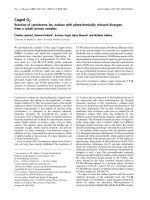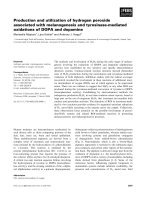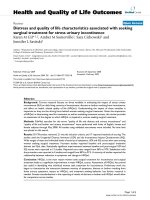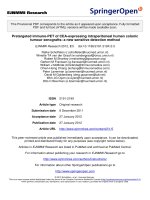Báo cáo toán học: "Almost Periodic Solutions of Evolution Equations Associated with C-Semigroups: An Approach Via Implicit Difference Equations" doc
Bạn đang xem bản rút gọn của tài liệu. Xem và tải ngay bản đầy đủ của tài liệu tại đây (143.14 KB, 10 trang )
Vietnam Journal of Mathematics 33:1 (2005) 63–72
Almost Periodic Solutions of Evolution Equations
Associated with C-Semigroups:
An Approach Via Implicit Difference Equations
*
Nguyen Minh Man
Faculty of Mathematics, Mechanics and Informatics
Vietnam National University, 334 Nguyen Trai, Hanoi, Vietnam
Received June 17, 2003
Revised November 29, 2004
Abstract. The paper is concerned with the existence of almost periodic mild solu-
tions to evolution equations of the form
˙u(t)=Au(t)+f(t)(∗), where A generates
a C-semigroup and
f is almost periodic. We investigate the existence of almost pe-
riodic solutions of
(∗) by means of associated implicit difference equations which are
well-studied in recent works on the subject. As results we obtain various sufficient
conditions for the existence of almost periodic solutions to
(∗) whichextendprevious
ones to a more general class of ill-posed equations involving C-semigroups. The paper
is supported by a research grant of the Vietnam National University, Hanoi.
In this paper we are concerned with the existence of almost periodic solutions
to equations of the form
du
dt
= Au + f (t), (1)
where A is a (unbounded) linear operator which generates a C-semigroup of
linear operators on Banach space X and f is an almost periodic function in the
sense of Bohr (for the definition and properties see [1, 6, 12]). We refer the reader
to [5, 10, 27, 28, 29] for more information on the definitions and properties of C-
semigroups and related ill-posed equations and to [3, 7, 34] for more information
∗
This work w a s supported by a research grant o f the Vietnam National University, Hanoi.
64 Nguyen Minh Man
on the asymptotic behavior of solutions of ill-posed equations associated with
C-semigroups.
The existence of almost periodic solutions to ill-posed evolution equations
of the form (1) has not been treated in mathematical literature yet except for
a recent paper by Chen, Minh and Shaw (see [3]) although many nice results
on the subject are available for well-posed equations (see e.g. [8, 17, 19,32] and
the refenreces therein). In this paper we study the existence of almost periodic
mild solutions of Eq. (1) by means of the associated implicit difference equation.
This approach goes back to the period map method which is very well known
in the theory of ordinary differential equations. Subsequently, this method has
been extended to study the existence of almost periodic solutions in [20]. By
this approach we obtain a necessary and sufficient condition (see Theorem 2.3)
for the existence of periodic solutions which extends a result in [18, 24, 32] to the
case of C-semigroups. As far as almost periodic mild solutions are concerned,
we obtain a sufficient condition (see Theorem 2.5) which extends a result in [20]
to ill-posed equations associated with C-semigroups.
1. Preliminaries
1.1. Notation
Throughout the paper, R, C, X stand for the sets of real, complex numbers
and a complex Banach space, respectively; L(X), C(J, X), BUC(R, X), AP (X)
denote the spaces of linear bounded operators on X,allX-valued continuous
functions on a given interval J,allX-valued bounded uniformly continuous and
almost periodic functions in Bohr’s sense (see definition below) with sup-norm,
respectively. For a linear operator A,wedenotebyD(A), σ(A) the domain of
A and the spectrum of A.
1.2. Spectral theory of functions
In the present paper sp(u) stands for the Beurling spectrum of a given bounded
uniformly continuous function u, which is defined by
sp(u):={ξ ∈ R : ∀ε>0, ∃ϕ ∈ L
1
(R) : supp ˜ϕ ⊂ (ξ − ε, ξ + ε),ϕ∗ u =0},
where
˜ϕ(s):=
∞
−∞
e
−ist
f(t)dt; ϕ ∗ u(s):=
∞
−∞
ϕ(s − t)u(t)dt.
The notion of Beurling spectrum of a function u ∈ BUC(R, X) coincides with the
one of Carleman spectrum, which consists of all ξ ∈ R such that the Carleman–
Fourier transform of u, defined by
ˆu(λ):=
∞
0
e
−λt
u(t)dt (Reλ>0)
−
∞
0
e
λt
u(−t)dt (Reλ<0),
Almost Periodic Solutions Equations Associated with C-Semigroups 65
has no holomorphic extension to any neighborhood of iξ (see [24, Prop. 0.5,
p. 22]).
Proposition 1.1. Let u ∈ BUC(R, X).Then
(i) sp(u) is closed,
(ii) sp(u(·)) = sp(u(· + h)), for all h ∈ R,
Proof. We refer the reader to [24, Prop. 0.4, Prop.0.6, Theorem 0.8, p. 20 -25].
1.3. Almost Periodic Functions
We recall that a subset E ⊂ R is said to be relatively dense if there exists
anumberl>0(inclusion length) such that every interval [a, a + l]containsat
least one point of E.Letf be a continuous function on R taking values in a
Banach space X. f is said to be almost periodic in the sense of Bohr if to every
>0 there corresponds a relatively dense set T (, f)(of -periods ) such that
sup
t∈R
f(t + τ) − f (t)≤, ∀τ ∈ T (, f).
If for all reals λ such that the following integrals
lim
T →∞
1
2T
T
−T
f(t)e
−iλt
dt
exist, then
a(λ, f ) := lim
T →∞
1
2T
T
−T
f(t)e
−iλt
dt
is called Fourier coefficients of f. As is well known (see e.g. [12]), if f is an
almost periodic function taking values in X, then there are at most countably
reals λ (Fourier exponents) such that a(λ, f) = 0, the set of which will be
denoted by σ
b
(f) and called Bohr spectrum of f. Throughout the paper we will
use the relation sp(f )=
σ
b
(f) and denote by AP (X) the space of all almost
periodic functions taking values in X with sup norm. We summarize several
main properties of almost periodic functions, whose proofs can be found in [12],
in the following theorem:
Theorem 1.2. The following assertions hold:
(i) f ∈ BC(R, X) is almost periodic if and only if for every sequence { τ
n
}
∞
n=1
⊂
R the sequence of functions {f
τ
n
= f (τ
n
+ ·)}
∞
n=1
contains at least a con-
vergent subsequence.
(ii) If f is X-valued almost periodic, then f ∈ BUC(R, X).
(iii) AP (X) is a closed subspace of BUC(R, X).
(iv) If f ∈ AP (X) and f
exists as an element of BUC(R, X),thenf
∈ AP (X).
1.4. Spectral Theory of Bounded Sequences
First we define the spectrum of a bounded sequence g := {g(n)}
n∈Z
in X
used in this paper. Recall that the set of all bounded sequences in X forms a
66 Nguyen Minh Man
Banach space l
∞
(X)withnormg := sup
n
g(n)
X
. We will denote by S(k)
the k-translation in l
∞
(X), i.e., (S(k)g)(n)=g(n + k), ∀g, n.
Definition 1.3. The subset of all λ of the unit circle Γ:={z ∈ C : |z| =1} at
which
ˆg(λ):=
∞
n=0
λ
−n−1
S(n)g, ∀|λ| > 1,
−
∞
n=1
λ
n−1
S(−n)g, ∀|λ| < 1,
has no holomorphic extension to any neighborhood in C of λ, is called the spec-
trum of the sequence g := {g(n)}
n∈Z
and will be denoted by σ(g).
We recall that a bounded sequence x is said to be almost periodic if it belongs
to the following subspace of l
∞
(X)
AP Z(X):=
span { λ
·
z,λ ∈ Γ,z ∈ X}, (2)
where (λ
·
z)(n):=λ
n
z, ∀n ∈ Z.
We list below some properties of the spectrum of g = {g(n)}.
Proposition 1.4. Let g := {g(n)} be a two-sided bounded sequence in X.Then
the following assertions hold:
(i) σ(g) is closed.
(ii) If g
n
is a sequence in l
∞
(X) converging to g such that σ(g
n
) ⊂ Λ for all
n ∈ N,whereΛ is a closed subset of the unit circle, then σ(g) ⊂ Λ.
(iii) If g ∈ l
∞
(X) and A is a bounded linear operator on the Banach space X,then
σ(Ag) ⊂ σ(g),whereAg ∈ l
∞
(X) is given by (Ag)(n):=Ag(n), ∀n ∈ Z.
(iv) Let the space X do not contain any subspace which is isomorphic to c
0
(the
Banach space of numerical sequences which converge to 0)andx ∈ l
∞
(X)
be a sequence such that σ(x) is countable. Then x is almost periodic.
1.5. C-semigroups: Definition and Basic Properties
Definition 1.5. Let X be a Banach space and let C be an injective operator in
L(X).Afamily{S(t); t ≥ 0} in L(X) is called a C-semigroup if the following
conditions are satisfied:
(i) S(0) = C,
(ii) S(t + s)C = S(t)S(s)C for t, s ≥ 0,
(iii) S(·)x:[0, ∞) → X is continuous for any x ∈ X,
(iv) There are M ≥ 0 and a ∈ R such that S(
t)≤Me
at
for t ≥ 0.
We define an operator G as follows:
D(G)={x ∈ X : lim
h→0
+
(S(h)x − Cx)/h ∈ R(C)}
Gx = C
−1
lim
h→0
+
(S(h)x − Cx)/h, ∀x ∈ D(G).
This operator is called the generator of (S(t))
t≥0
.ItisknownthatG is closed
but the domain of G is not necessarily dense in X.
Almost Periodic Solutions Equations Associated with C-Semigroups 67
Lemma 1.6. Let C be an injective linear operator and let (S(t))
t≥0
be a C-
semigroup with generator A. Then, the following assertions hold true:
(i) S(t)S(s)=S(s)S(t), ∀t, s ≥ 0,
(ii) If x ∈ D(A),thenS(t)x ∈ D(A), AS(t)x = S(t)Ax and
t
0
S(ξ)Axdξ = S(t)x − Cx, ∀t ≥ 0,
(iii)
t
0
S(ξ)xdξ ∈ D(A) and A
t
0
S(ξ)xdξ = S(t)x − Cx for every x ∈ X and
t ≥ 0,
(iv) A is closed and satisfies C
−1
AC = A,
(v) R(C) ⊂
D(A).
For more information about C-semigroups we refer the reader to [5, 10, 13, 14].
2. Main Results
We always assume that C is an injection and {T (t); t ≥ 0} is a C-semigroup
with generator A. Below we introduce some notions of solutions. We denote by
J an interval of the form (α, β), [α, β), (α, β]or[α, β].
Definition 2.1.
(i) An X-valued function u ∈ C
1
(J, X) is called a (classical) solution on J to
Eq. (1) for a given f ∈ C(J, X) if u(t) ∈ D(A), ∀t ∈ J and u, f satisfy
Eq. (1) for all t ∈ J.
(ii) An X-valued function u on J is called a mild solution on J to Eq. (1) for a
given f ∈ C(R, X) if u(t) is continuous in t and satisfies
Cu(t)=T (t − s)u(s)+
t
s
T (t − r)f(r)dr, ∀t ≥ s; t, s ∈ J. (3)
As shown in [3] every classical solution is a generalized one. However, given
an initial value u(t
0
)=x ∈ X we do not know if there exists a mild solution
Eq. (1) starting at this point.
Lemma 2.2. Let R(C) be closed, x ∈ R(C) and let f(t) ∈ R(C) be continuous
for all t ∈ [t
0
, ∞). Then there exists a unique mild solution u to Eq. (1) on
[t
0
, ∞) such that u(t
0
)=x and u(t) ∈ R(C), ∀t ∈ [t
0
, ∞).
Proof. By the Open Mapping Theorem and the assumptions the operator C
−1
is continuous from R(C)toX. Using the indentity T (t)C = CT(t), ∀t ∈ [0, ∞)
we define a function u as
u(t)=T (t − t
0
)C
−1
x +
t
t
0
T (t − ξ)C
−1
f(ξ)dξ, ∀t ≥ t
0
.
Since C
−1
is continuous and x, f (t) ∈ R(C)wehavethatu is a continuous
function defined on [t
0
, ∞)andu(t) ∈ R(C), ∀t ∈ [t
0
, ∞). We now show that u
is a mild solution of Eq. (1) on [t
0
, ∞). In fact, we have
68 Nguyen Minh Man
C
2
u(t)=CT(t − t
0
)x + C
t
t
0
T (t − ξ)f(ξ)dξ
= CT(t − s)T (s − t
0
)x + C
t
t
0
T (t − ξ)f(ξ)dξ
= CT(t − s)T (s − t
0
)x + C
s
t
0
T (t − s)T (s − ξ)f (ξ)dξ + C
t
s
T (t − ξ)f(ξ)dξ
= T (t − s)Cu(s)+C
t
s
T (t − ξ)f(ξ)dξ, ∀t ≥ s ≥ t
0
.
Since C is an injection and by the identity CT(t)=T (t)C the above yields that
Cu(t)=T (t − s)u(s)+
t
s
T (t − ξ)f(ξ)dξ, ∀t ≥ s ≥ t
0
,
and so, by definition, u is a mild solution of Eq. (1) on [t
0
, ∞). The uniqueness
of such a solution is obvious.
2.1. Periodic Solutions
We will use the following notation in the remaining part of this paper
ρ
C
(T (1)) := {λ ∈ C :(λC − T (1)) : R(C) → R(C) is bijective}.
Note that this definition is possible because of CT(1) = T (1)C.
Theorem 2.3. Let R(C) be closed. Then Eq. (1) has a unique 1-periodic mild
solution u with u(t) ∈ R(C) for every 1-periodic f ∈ C(R,R(C)) provided that
1 ∈ ρ
C
(T (1)).
Proof. Suppose that 1 ∈ ρ
C
(T (1)). We now prove that for every 1-periodic
continuous f with f (t) ∈ R(C), ∀t ∈ R there exists a unique 1-periodic mild
solution u to Eq. (1) such that u(t) ∈ R(C), ∀t ∈ R.Infact,letx :=
1
0
T (1 −
ξ)f(ξ)dξ. Then, by assumption, we have x ∈ R(C). Next, consider the element
y ∈ R(C) such that (C − T (1))y = x whose existence is guaranteed by the
assumption. By Lemma 2.2 there exists a unique mild solution u to Eq. (1) on
[0, ∞) such that u(t) ∈ R(C), ∀t ∈ [0, ∞)andu(0) = y.Next,wehave
Cu(1) = T (1)y + x.
Since C is injective, u(1) = y. By the 1-periodicity of f , this shows that u
can be extended to a 1-periodic mild solution of Eq. (1). The uniqueness of
such 1-periodic solutions follows from the uniqueness of the element y from the
equation (C − T (1))y = x.
2.2. Almost Periodic Solutions
Almost Periodic Solutions Equations Associated with C-Semigroups 69
We will give a sufficient conditions for the existence of almost periodic mild
solutions to Eq. (1).
Proposition 2.4. Let C be an injection with closed range and let f be an almost
periodic function such that f (t) ∈ R(C), ∀t ∈ R. Then, any mild solution u on
R of Eq. (1) is almost periodic provided that the sequence {u(n)}
n∈Z
is almost
periodic.
Proof. The proof of this proposition is suggested by that of [20]. We first prove
the sufficiency: Suppose that the sequence x is almost periodic. Note that the
function w(t):=su(n)+(1− s)u(n +1), if t = sn +(1− s)(n +1),s∈ [0, 1],
as a function defined on the real line, is almost periodic. Also, the function
taking t into g(t):=(w(t),f(t)) is almost periodic (see [12, p.6]). As is seen, the
sequence {g(n)} = {(w(n),f(n))} is almost periodic. Hence, for every positive
the following set is relatively dense (see [6, pp. 163-164])
T := Z ∩ T (g, ), (4)
where T (g, ):={τ ∈ R :sup
t∈R
g(t + τ) − g(t) <}, i.e., the set of periods
of g. Hence, for every m ∈ T we have
f(t + m) − f (t) <, ∀t ∈ R, (5)
u(n + m) − u(n) <, ∀n ∈ Z. (6)
Moreover, by the Open Mapping Theorem, C
−1
: R(C) → X is bounded. Thus,
using the identity CT(t)=T (t)C we have
u(n + m + s) − u(n + s)≤C
−1
T (s)(u(n + m) − u(n))
+
s
0
T (s − ξ)C
−1
(f(n + ξ + m) − f(n + ξ))dξ
≤C
−1
R(C)→X
[Ne
ω
u(n + m) − u(n)
+ N
e
ω
ω
sup
t∈R
f(m + t) − f(t)].
In view of (5) and (6) m is a max
1,
1
ω
Ne
ω
-period of the function u. Finally,
since T is relatively dense for every ,weseethatu is an almost periodic mild
solution of Eq. (1).
Below we always assume that the conditions of Proposition 2.4 are satisfied.
We consider the difference equation
Cx(n +1)=T (1)x(n)+g(n),n∈ Z, (7)
where
g(n):=
n+1
n
T (n +1− ξ)f(ξ)dξ, n ∈ Z.
Obviously, g(n) ∈ R(C) for all n ∈ Z. Consider the space Y := AP Z
Λ
(R(C)
with translation S : x(·) → x(· +1), whereΛ:=σ(g). We rewrite Eq. (8) in the
abstract form
70 Nguyen Minh Man
(
˜
CS −
˜
T (1))x = g, (8)
where
˜
C and
˜
T (1) are the operators of multiplication by C and T (1) in Y,
respectively. Since C is invertible in R(C)andg ∈ R(C), we will solve x as a
solution of the equation (S −
˜
C
−1
˜
T (1))x =
˜
C
−1
g.Nowwehave
Theorem 2.5. Let all assumptions of Proposition 2.4 be satisfied. Moreover,
assume that
e
isp(f )
∩ σ(C
−1
T (1)|
R(C)
)=∅.
Then, there exists an almost periodic solution to Eq. (1).
Proof. As in the above argument, it is sufficient to prove that Eq. (8) has a
solution in Y. Since the operators S,
˜
C
−1
T (1) are commutative and σ(S)=Λ⊂
e
isp(f )
we have that
σ(S −
˜
C
−1
˜
T (1)) ⊂ σ(S) − σ(
˜
C
−1
˜
T (1)) = Λ − σ(
˜
C
−1
˜
T (1)).
By the assumption e
isp(f )
∩σ(C
−1
T (1)|
R(C)
)= we have Λ ∩ σ(
˜
C
−1
˜
T (1)) = .
Therefore, 1 ∈ Λ − σ(C
−1
T (1)). This shows that the operator (S −
˜
C
−1
˜
T (1)) is
invertible, so Eq. (8) has at least a solution in Y. That is the difference equations
(7) has at least one almost periodic solution. Using the injectiveness of C and
Lemma 2.2 we can construct a mild solution u to Eq. (1) defined on the whole
line such that u(n)=x(n). By Proposition 2.4, we claim that the mild solution
u should be almost periodic.
Acknowledgement. The author is grateful to Professor Nguyen Van Minh for pointing
out the problem and constant interest.
References
1. L. Amerio and G. Prouse, Almost Periodic Functions and Functional Equations,
Van Nostrand Reinhold, New York, 1971.
2. W. Arendt and C. J. K. Batty, Almost periodic solutions of first and second oder
Cauchy problems, J. Differential Equations 137 (1997) 363–383.
3. J-C. Chen, Nguyen Van Minh, and S-Y. Shaw, C-Semigroups and almost periodic
solutions of evolution equations, Preprint.
4. G. Da Prato, Semigruppi Regolarizzibili, Recerche di Mat. 15 (1966) 223–248.
5. R. deLaubenfels, Existence Families, Functional Calculi and Evolution Equations,
Lecture Notes in Math., 1570, Springer-Verlag, Berlin, 1994.
6. A. M. Fink, Almost Periodic Differential Equations, Lecture Notes in Math. 377,
Springer-Verlag, Berlin, New York, 1974.
7. X. Gu, M. Li, and F. Huang, Almost periodicity of
C-semigroups, integrated
semigroups and
C-cosine functions, Studia Math. 150 (2002) 189–200.
8. Y. Hino, T. Naito, N. V. Minh, and J. S. Shin, Almost Periodic Solutions of Dif-
ferential Equations in Banach Spaces, Taylor & Francis, London, New York, 2002.
Almost Periodic Solutions Equations Associated with C-Semigroups 71
9. Y. Katznelson, An Introduction to Harmonic Analysis, Dover Publications, New
York, 1968.
10. C C. Kuo and S-Y. Shaw, On
α-times integrated C-semigroups and the abstract
Cauchy problem, Studia Math. 142 (2000) 201–217.
11. C C. Kuo and S-Y. Shaw, Abstract Cauchy problems associated with local
C-
semigroups, Preprint.
12. B. M. Levitan and V. V. Zhikov, Almost Periodic Functions and Differential Equa-
tions, Moscow Univ. Publ. House 1978. English translation by Cambridge Uni-
versity Press 1982.
13. M. Li, F. Huang, and Q. Zheng, Local integrated
C-semigroups, Studia Math.
145 (2001) 265–280.
14. Y C. Li and S Y. Shaw,
N-times integrated C-semigroups and the abstract
Cauchy problem, Taiwanese J. Math. 1 (1997) 75–102.
15. J. L. Massera, The existence of periodic solutions of systems of differential equa-
tions, Duke Math. J. 17 (1950) 457–475.
16. Nguyen Van Minh and Nguyen Minh Man, On the asymptotic behavior of solu-
tions of neutral delay difference equations (Submitted).
17. S. Murakami, T. Naito, and N. V. Minh, Evolution semigroups and sums of com-
muting operators: a new approach to the admissibility theory of function spaces,
J. Differential Equations 164 (2000) 240–285.
18. T. Naito and N. V. Minh, Evolution semigroups and spectral criteria for almost
periodic solutions of periodic evolution equations, J. Differential Equations 152
(1999) 358–376.
19. T. Naito, N. V. Minh, and J. S. Shin, New spectral criteria for almost periodic
solutions of evolution equations, Studia Math. 145 (2001) 97–111.
20. T. Naito, N. V. Minh, R. Miyazaki, and Y. Hamaya, Boundedness and almost pe-
riodicity in dynamical systems, J. Difference Equations and Applications 7 (2001)
507–527.
21. J. van Neerven, The asymptotic Behaviour of Semigroups of Linear Operator,
Birkhauser Verlag, Basel, Boston, Berlin, Operator Theory, Advances and Appli-
cations Vol. 88, 1996.
22. G. M. N’Guerekata Almost Automorphic and Almost Periodic Functions in Ab-
stract Spaces, Kluwer, Amsterdam, 2001.
23. A. Pazy, Semigroups of linear operators and applications to Partial differential
equations, Applied Math. Sci. 44, Spriger-Verlag, Berlin-New York, 1983.
24. J. Pr¨uss, Evolutionary Integral Equations and Applications,Birkh¨auser, Basel,
1993.
25. W. Rudin, Functional Analysis,2
nd
, McGraw-Hill Inc., New York, 1991.
26. W. M. Ruess and Q. P. Vu, Asymptotically almost periodic solutions of evolution
equations in Banach spaces, J. Differential Equations 122 (1995) 282–301.
27. S-Y. Shaw and C. C. Kuo, Generation of local
C-semigroups and solvability of the
abstract Cauchy problems, Preprint.
28. N. Tanaka, On the exponentially bounded
C-semigroups, Tokyo J. Math. 10
(1987) 107–117.
29. N. Tanaka and I. Miyadera, Exponentially bounded
C-semigroups and integrated
semigroups, Tokyo J. Math. 12 (1989) 99–115.
72 Nguyen Minh Man
30. N. Tanaka and I. Miyadera,
C-semigroups and the abstract Cauchy problem, J.
Math. Anal. Appl. 170 (1992) 196–206.
31. Phi T. V. Anh, On the spectral conditions for the existence of almost periodic solu-
tions to implicit difference equations, Master Thesis, Hanoi University of Science,
2001.
32. Q. P. Vu and E. Sch¨uler, The operator equation
AX − XB = C, stability
and asymptotic behaviour of differential equations, J. Differential Equations 145
(1998) 394–419.
33. S. Zaidman, Topics in Abstract Differential Equations, Pitman Research Notes in
Mathematics Series, 304, Longman Scientific & Technical, New York, 1994.
34. Q. Zheng and L. Liu, Almost periodic regularized groups, semigroups and cosine
functions, J. Math. Anal. Appl. 197 (1996) 90–112.









